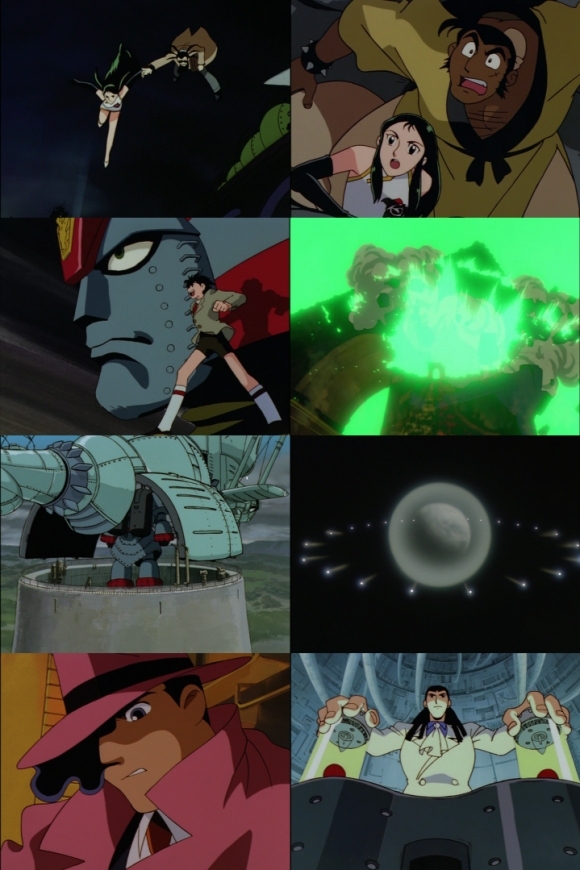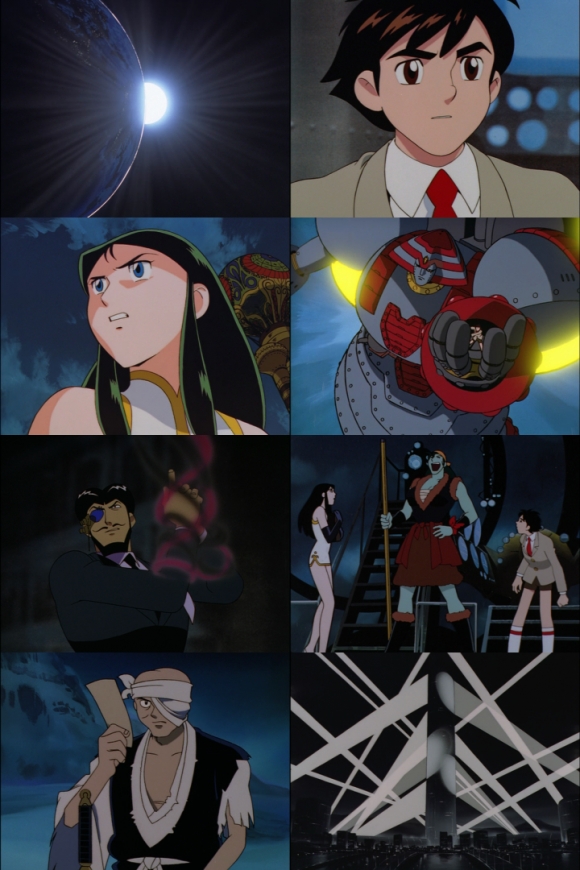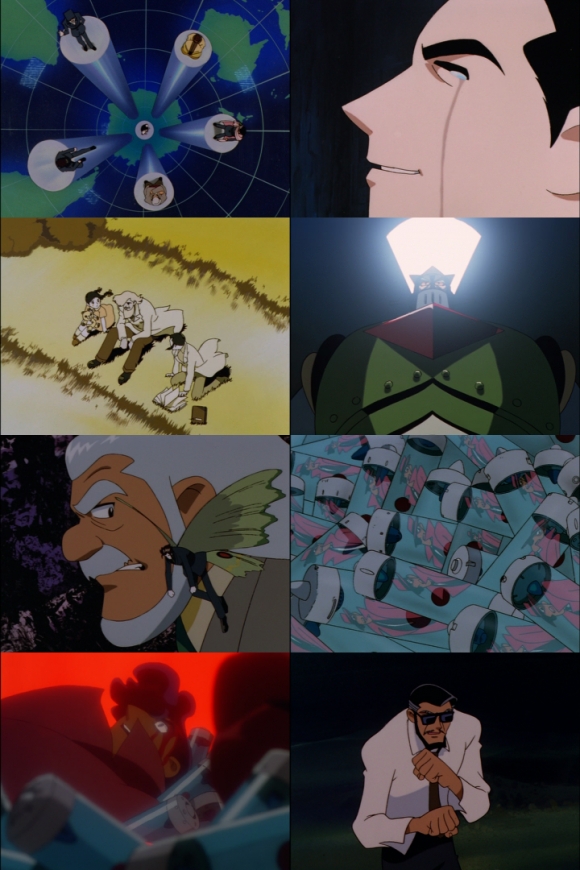A Boy And His Robot
<cite>Giant Robo: The Day The Earth Stood Still</cite> (1992)
 Deep down, I worry about the anime industry. I can’t tell if it’s the influx of titles that seem to be about liking girls who are 14 or younger, or the fact that for a medium that has international roots, anime these days is more insular than ever. In any event, there are points where I wonder how much lower things can go before I finally lose interest in this medium. When I feel like this, I watch something that makes me resolve my doubts. It’s my comfort food, it’s a tale of courage and villainy and it’s fitting as the anniversary post for the Trap Door. It’s Yasuhiro Imagawa’s OVA, Giant Robo: The Day The Earth Stood Still.
Deep down, I worry about the anime industry. I can’t tell if it’s the influx of titles that seem to be about liking girls who are 14 or younger, or the fact that for a medium that has international roots, anime these days is more insular than ever. In any event, there are points where I wonder how much lower things can go before I finally lose interest in this medium. When I feel like this, I watch something that makes me resolve my doubts. It’s my comfort food, it’s a tale of courage and villainy and it’s fitting as the anniversary post for the Trap Door. It’s Yasuhiro Imagawa’s OVA, Giant Robo: The Day The Earth Stood Still.
Taking character designs from Mitsuteru Yokoyama’s various manga over the years and adapting one of his most famous stories, Giant Robo, Imagawa’s anime tells of the final, terrible, conflict between the International Police Organisation (IPO) and their team, Experts of Justice and the crime organisation Big Fire (Hail Big Fire! Allegiance or Death!!) and their own team, the Magnificent Ten, during a golden age of humankind brought on the “Shizuma Drive.” The drive has allowed free, clean energy but there is a horrific secret at its core. Smack in the middle of this fight is Daisaku Kusuma, the young boy in control of the former BF robot, Giant Robo and allied with the EoJ. This war will decide the fate of mankind and the answer to a question Daisaku’s late father once asked of his son. Nearly ten years in the making, Giant Robo was a series of OVAs that Imagawa slaved away on while working on G Gundam and Berserk as director and writer. Set in a kind of quasi-steampunk setting before that genre was run into the ground, it’s got spies, assassins, meta-humans, robots, nuclear destruction and more one-on-one fights than a Sergio Leone film.

This series uses Yokoyama’s designs for both people and things and is steeped in a classical style that feels like it could be from any time in anime’s history. There are elements of wuxia films in the way Professor Go dresses and acts along with two of the EoJ’s best fighters, the brothers Tetsugyu and Taiso as they act and are dressed in the style of 18th or 19th century heroes of old. Also, the duels that happen between the EoJ and Mag-10 are tried and true circling with the opponents trying to size each other before making their first (and in some cases only) move. The way that Robo is used to show the scale of the buildings and places he’s in since he himself is at least a hundred feet tall gives you some idea of the scale of the set pieces. When Robo and Daisaku go into battle, the earth and heavens shake and we get contrasting close-ups alongside Daisaku and long shots as district-shattering blows are rained down on the machines involved. Massive machines destroy Shanghai in a attempt to capture one man and an attache case. Military bases are set ablaze as people battle atop the ruins in lightning fast duels. Robo tackles a sphere the size of a small moon. If this were all there was to Giant Robo, then it would be enough to satisfy most, me included. But there’s more. Much much more!

The lead, Daisaku, is a young man who’s trying to understand his way in the world. He takes after people like Professor Go, a calm and reasoned man who knows what is sometimes required so that others might live, or Taiso, a man for whom the idea of not fighting with every last drop of strength and honor in your body is tantamount to mental treason. Daisaku controls a giant robot that only responds to his command and this certainty has allowed him to help the Experts on missions where most normal people couldn’t. But he’s never had to make tough decisions, ones that decided the fate of the world. For all their bluster, Big Fire is more in the Adam West Batman school of villainy but the people they’re allied with will force everyone, including Daisaku, to make unforgettable choices. Daisaku has a slight crush on Ginrei, the feisty and no nonsense female agent who has a personal interest in this latest case. For Daisaku, she is the big sister he could have had. For Ginrei, Daisaku represents the last place her own innocence can take refuge in the world she knows. Tetsugyu comes across as all bluster and no brains but he really does have the heart of a bear and fortitude of a samurai warrior. His jealous mutterings about Daisaku spending time with Ginrei as HIS crush on Ginrei goes unrequited give way to a man-child who becomes a man as he stands for what he believes in and lives with the choice. Other people like Professor Go and the Chief help Daisaku become a better person rather than a man. When he finds out the truth behind the battle, it’s shocking but goes to the heart of the final moments he had with his late father. A brilliant man, he designed Giant Robo for Big Fire but decided to turn the machine over to the IPO and gave voice command control to his son. In their last talk, he asked his son to find the answer to whether or not people could achieve true happiness without some form of sacrifice.

The other question he asked goes to the other heart of the show: can a new era be born without tragedy? For Genya, a man determined to make the world pay for their vilification of a dead man, this new era of clean energy and peace is built on lies and the countless lives that were extinguished in what all the players describe as The Tragedy of Bashtarlle. The actual event is first told in half scenes, without substance and in shadow, then in more elaborate sequences. As Genya allies himself with Big Fire Group and Mag-10, his plan to punish the world steps up and every evil perpetrated is mere window dressing, the last act starts and the conflict comes to it’s conclusion. While this is beyond the horror of anything that we can imagine, the reasons Genya has, once you know them, seem to justify themselves. All the world is living a lie, known only to a few, and a good man paid the price for trying to do the right thing. The show’s strength are that we feel for the people caught in the crossfire and for the people forced to make the decisions. Even when Big Fire point man Alberto realises what Genya intends to do, he tries to prevent it. From what I could see, it was more to do with the fact that Genya lied to Big Fire rather than it being evil (they are villains after all). All this tragedy could have been avoided if Genya and a few others had been able to make sense of Bashtarlle without having the world revile them. In the end, the people at the heart of that incident come to the same place physically but have radically different outlooks on life. The final battle is heartstring tugging and full on emotional with both the side of good and bad having to pay in full. In an operatic showdown of earth-shattering proportions, Genya’s plan meets the power of one boy and his robot as every one of Daisaku’s friends and allies give their all so that the best of them can stand up for his ideals and make the place better than when he started. Without knowing it at the beginning, Daisaku gets to see that good and bad are two sides of the same coin and that happiness will win out against sadness so long as there are people to defend it.

The full title of the show includes “The Day The Earth Stood Still”. This is a double reference with one being the shutdown of the Earth’s Shizuma drives and the other being the classic 1951 science fiction film of the same name. In that, an alien named Klaatu and a robot named Gort come to Earth to make contact and open relations. Due to our fears and insecurities, Gort near destroys humanity before a few brave humans and Klaatu stop him. In both stories, we are almost destroyed by ourselves and the only real difference is the threats come from inside and outside the Earth. In the original film, the power of our technology is laid waste by Klaatu’s science and in the anime, Genya’s Blessed Night sphere does the same. The resolve in the end for Klaatu and his new friends is that unless we give up our need to destroy and the need for quick fixes, the planet and humanity are both doomed. A similar scenario occured to me while watching Giant Robo.
For me, the emotional soul of the series is Masamichi Amano’s musical triumph. A masterpiece of both Wagnerian opera styles and the film scores of Bernard Herrmann, Alfred Neumann, Max Steiner, and especially Erich Wolfgang Korngold, the score has simply no equal in anime even today. In much the same way as Star Wars reopened the Romantic style of filmscore back into Hollywood films, Giant Robo uses a sweeping, honest-to-God adventure score and employs the Warsaw Philharmonic Orchestra and Choir with Amano composing, arranging and conducting the orchestra. When you consider that Nippon Columbia rung seven soundtracks, one for each episode I’d imagine, the score is something to find online, if you can. Every time Daisaku is swept up by his faithful companion, the score goes into high adventure and lashings of mecha derring-do. The murky treachery of Big Fire brings the classic moody, accusing violins of a Warner or MGM 50’s thriller. When we learn about Bashtarlle, Amano goes for full Gregorian laments and Italian romanzas as the world crumbles around both Big Fire, Genya’s Sphere, and the Experts of Justice. Finally, the overarching theme of the show is a brilliant lover letter to the scores of Elmer Bernstein and Miklós Rózsa and the epics of the fifties with a little bit of John Williams thrown in for good measure.

Sadly, the plan to do a prequel showing how Daisaku came to be with the IPO never came to fruition for director and writer Imagawa. The show was so long in production, that by the end sales probably couldn’t justify going back and doing more. The era of the OVA was waning in 1998 and full blown control by TV and music companies was being reestablished, so who would want to see more retro-styled anime? Despite this, it did trigger a continued revival in reimagining the works of people like Osamu Tezuka and Go Nagai as well as a revival by Imagawa of Yokoyama’s other big title Tetsujin-28 in 2004. There was another Giant Robo show in the 21st century called GR: Giant Robo (2007) and a manga written by Imagawa called Giant Robo: The Day the Earth Burned in 2006. I feel like there should be more Giant Robo but in a different setting from The Day the Earth Stood Still as it finishes its story and there is no further need to visit this world. I want to recommend other titles like it but there are simply none to my mind that come close to its perfect balance of music, character, setting, pace, tone, and construction. So, go and find it online on eBay or Amazon. All of it plus the Ginrei comedy special were released by Media Blasters years ago and include the Japanese language track plus both the NYAV and the older Streamline dubs as well. It can be expensive but steals can be found if you keep a sharp weather eye for them.
I’ve been planning to do Giant Robo on the Trap Door since at least the summer of last year. I’m sorry it’s taken so long to write this but hopefully you will try out the show and enjoy it as much as I have.
Lastly, I have two important announcments, one great and one slightly sad. First up, with Discotek licensing more Lupin The 3rd, I’m going to do a season of the films and specials that are currently available sometime in the summer of this year. While I will try and find the FUNimation releases (they are getting harder to find for decent prices), it’s a surer bet that I’ll be using the Discotek releases for my material.
The second announcment is I have decided to close the Trap Door column as a monthly section of Ani-Gamers in the foreseeable future. While I’ve enjoyed my time here, I’m starting to notice that I’m looking forward to not having to worry about what to watch for Trap Door once each month’s post goes up. Aside from one month, I have not missed a post in two years and want to finish this out with an unblemished record. So with that in mind, here’s how the column will be wound down:
- From next month, I will be doing one post a month until March of next year. A lot of these will be pre-written for workflow reasons including the Lupin season so if I don’t make mention of any comments I get each month, you’ll know why.
- Second, I’ll be publishing tentative lists of what I’ll be writing about so you can get comments or questions in ahead of time. If you know someone who might be curious or who knows about whatever I’ll be writing on, pass on the details to them!
- Finally, after March 2015, I will be doing two bonus posts to bring us up to the summer as Ani-Gamers is going to do something special for my final entry for Trap Door. I won’t tell you what the final post will be and nor will I be giving out any clues. You’ll just have to wait and see.
It’s too soon to say goodbye yet but we’re on our way to the last stop on the track! Hope you’ll all join me!
